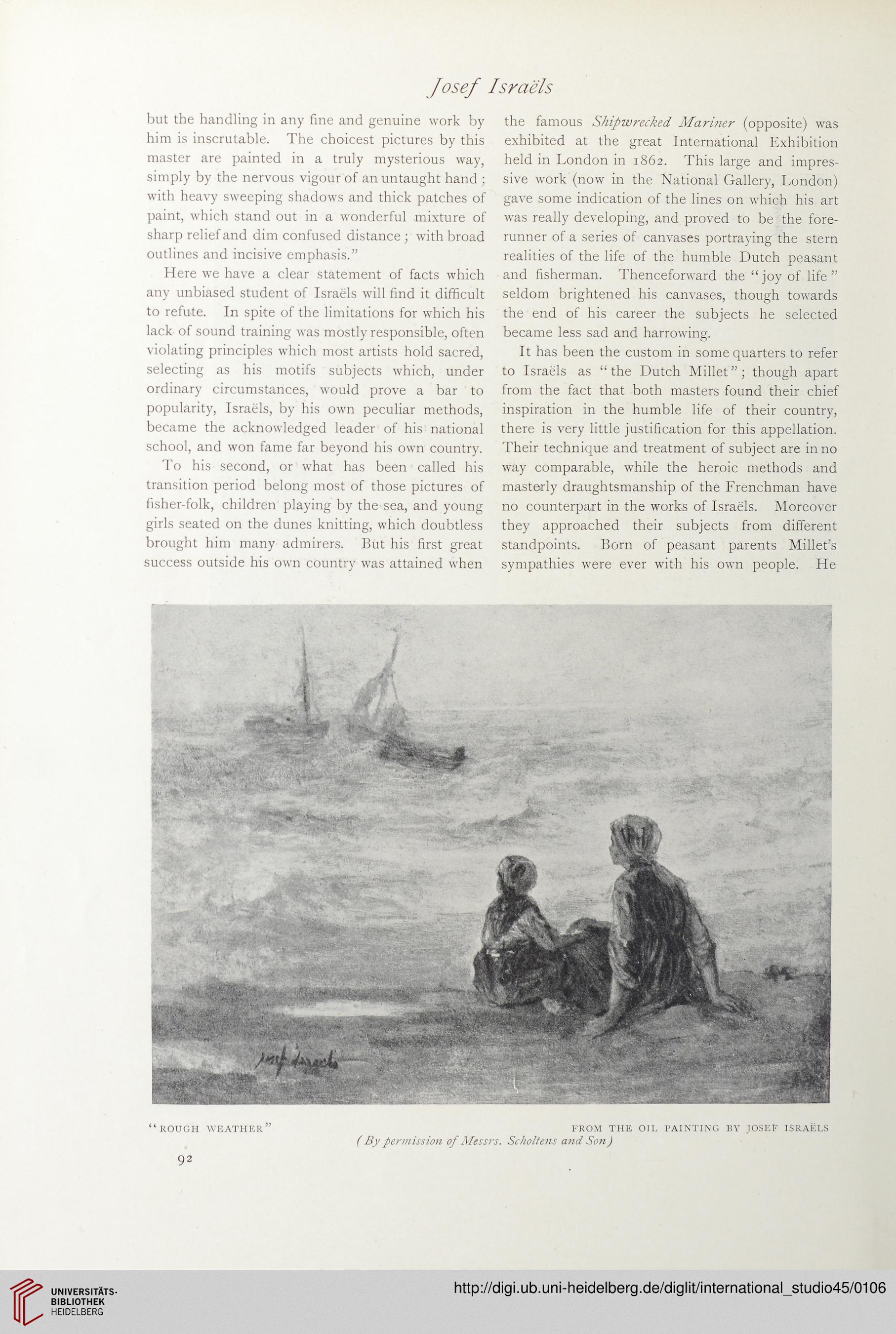Josef Israels
but the handling in any fine and genuine work by
him is inscrutable. The choicest pictures by this
master are painted in a truly mysterious way,
simply by the nervous vigour of an untaught hand ;
with heavy sweeping shadows and thick patches of
paint, which stand out in a wonderful mixture of
sharp relief and dim confused distance ; with broad
outlines and incisive emphasis.”
Here we have a clear statement of facts which
any unbiased student of Israels will find it difficult
to refute. In spite of the limitations for which his
lack of sound training was mostly responsible, often
violating principles which most artists hold sacred,
selecting as his motifs subjects which, under
ordinary circumstances, would prove a bar to
popularity, Israels, by his own peculiar methods,
became the acknowledged leader of his national
school, and won fame far beyond his own country.
To his second, or what has been called his
transition period belong most of those pictures of
fisher-folk, children playing by the sea, and young
girls seated on the dunes knitting, which doubtless
brought him many admirers. But his first great
success outside his own country was attained when
the famous Shipwrecked Mariner (opposite) was
exhibited at the great International Exhibition
held in London in 1862. This large and impres-
sive work (now in the National Gallery, London)
gave some indication of the lines on which his art
was really developing, and proved to be the fore-
runner of a series of canvases portraying the stern
realities of the life of the humble Dutch peasant
and fisherman. Thenceforward the “ joy of life ”
seldom brightened his canvases, though towards
the end of his career the subjects he selected
became less sad and harrowing.
It has been the custom in some quarters to refer
to Israels as “the Dutch Millet”; though apart
from the fact that both masters found their chief
inspiration in the humble life of their country,
there is very little justification for this appellation.
Their technique and treatment of subject are in no
way comparable, while the heroic methods and
masterly draughtsmanship of the Frenchman have
no counterpart in the works of Israels. Moreover
they approached their subjects from different
standpoints. Born of peasant parents Millet’s
sympathies were ever with his own people. He
“rough weather”
FROM THE OIL PAINTING BY JOSEF ISRAELS
( By permission of Messrs. Scholtens and Son)
92
but the handling in any fine and genuine work by
him is inscrutable. The choicest pictures by this
master are painted in a truly mysterious way,
simply by the nervous vigour of an untaught hand ;
with heavy sweeping shadows and thick patches of
paint, which stand out in a wonderful mixture of
sharp relief and dim confused distance ; with broad
outlines and incisive emphasis.”
Here we have a clear statement of facts which
any unbiased student of Israels will find it difficult
to refute. In spite of the limitations for which his
lack of sound training was mostly responsible, often
violating principles which most artists hold sacred,
selecting as his motifs subjects which, under
ordinary circumstances, would prove a bar to
popularity, Israels, by his own peculiar methods,
became the acknowledged leader of his national
school, and won fame far beyond his own country.
To his second, or what has been called his
transition period belong most of those pictures of
fisher-folk, children playing by the sea, and young
girls seated on the dunes knitting, which doubtless
brought him many admirers. But his first great
success outside his own country was attained when
the famous Shipwrecked Mariner (opposite) was
exhibited at the great International Exhibition
held in London in 1862. This large and impres-
sive work (now in the National Gallery, London)
gave some indication of the lines on which his art
was really developing, and proved to be the fore-
runner of a series of canvases portraying the stern
realities of the life of the humble Dutch peasant
and fisherman. Thenceforward the “ joy of life ”
seldom brightened his canvases, though towards
the end of his career the subjects he selected
became less sad and harrowing.
It has been the custom in some quarters to refer
to Israels as “the Dutch Millet”; though apart
from the fact that both masters found their chief
inspiration in the humble life of their country,
there is very little justification for this appellation.
Their technique and treatment of subject are in no
way comparable, while the heroic methods and
masterly draughtsmanship of the Frenchman have
no counterpart in the works of Israels. Moreover
they approached their subjects from different
standpoints. Born of peasant parents Millet’s
sympathies were ever with his own people. He
“rough weather”
FROM THE OIL PAINTING BY JOSEF ISRAELS
( By permission of Messrs. Scholtens and Son)
92




